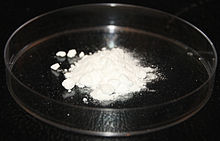
Phthalic anhydride

Phthalic anhydride is the organic compound with the formula C6H4(CO)2O. It is the anhydride of phthalic acid. Phthalic anhydride is a principal commercial form of phthalic acid. It was the first anhydride of a dicarboxylic acid to be used commercially. This white solid is an important industrial chemical, especially for the large-scale production of plasticizers for plastics. In 2000, the worldwide production volume was estimated to be about 3 million tonnes per year. Phthalic anhydride is the organic compound with the formula C6H4(CO)2O. It is the anhydride of phthalic acid. Phthalic anhydride is a principal commercial form of phthalic acid. It was the first anhydride of a dicarboxylic acid to be used commercially. This white solid is an important industrial chemical, especially for the large-scale production of plasticizers for plastics. In 2000, the worldwide production volume was estimated to be about 3 million tonnes per year. Phthalic anhydride was first reported in 1836 by Auguste Laurent. More contemporary routes include oxidation of naphthalene or ortho-xylene. Vanadium pentoxide (V2O5) is the active oxidant for several key steps of the processes, and is regenerated by molecular oxygen. Starting from o-xylene, the oxidation reaction is run at about 320–400 °C and has the following stoichiometry: The reaction proceeds with about 70% selectivity. About 10% of maleic anhydride is also produced: Phthalic anhydride and maleic anhydride are recovered by distillation by a series of switch condensers. The naphthalene route (the Gibbs phthalic anhydride process or the Gibbs–Wohg naphthalene oxidation reaction), a process whose use has declined in compared to the o-xylene route, has the following mechanism: Phthalic anhydride can also be prepared from phthalic acid by simple dehydration. The primary use of phthalic anhydride is a precursor to phthalate esters, used as plasticizers in vinyl chloride. Phthalate esters are derived from phthalic anhydride by the alcoholysis reaction. In the 1980s, approximately 6.5×109 kg of these esters were produced annually, and the scale of production was increasing each year, all from phthalic anhydride. The process begins with the reaction of phthalic anhydride with alcohols, giving the monoesters:
